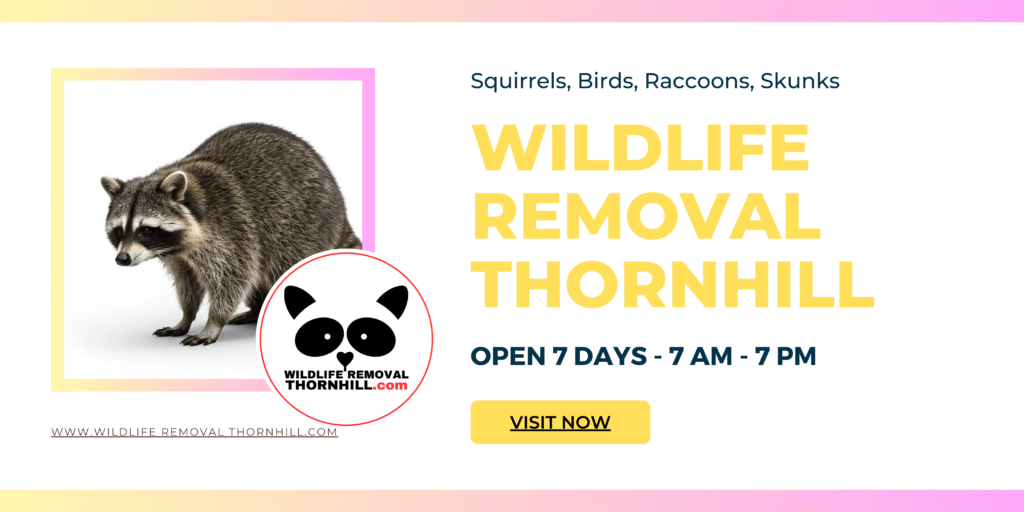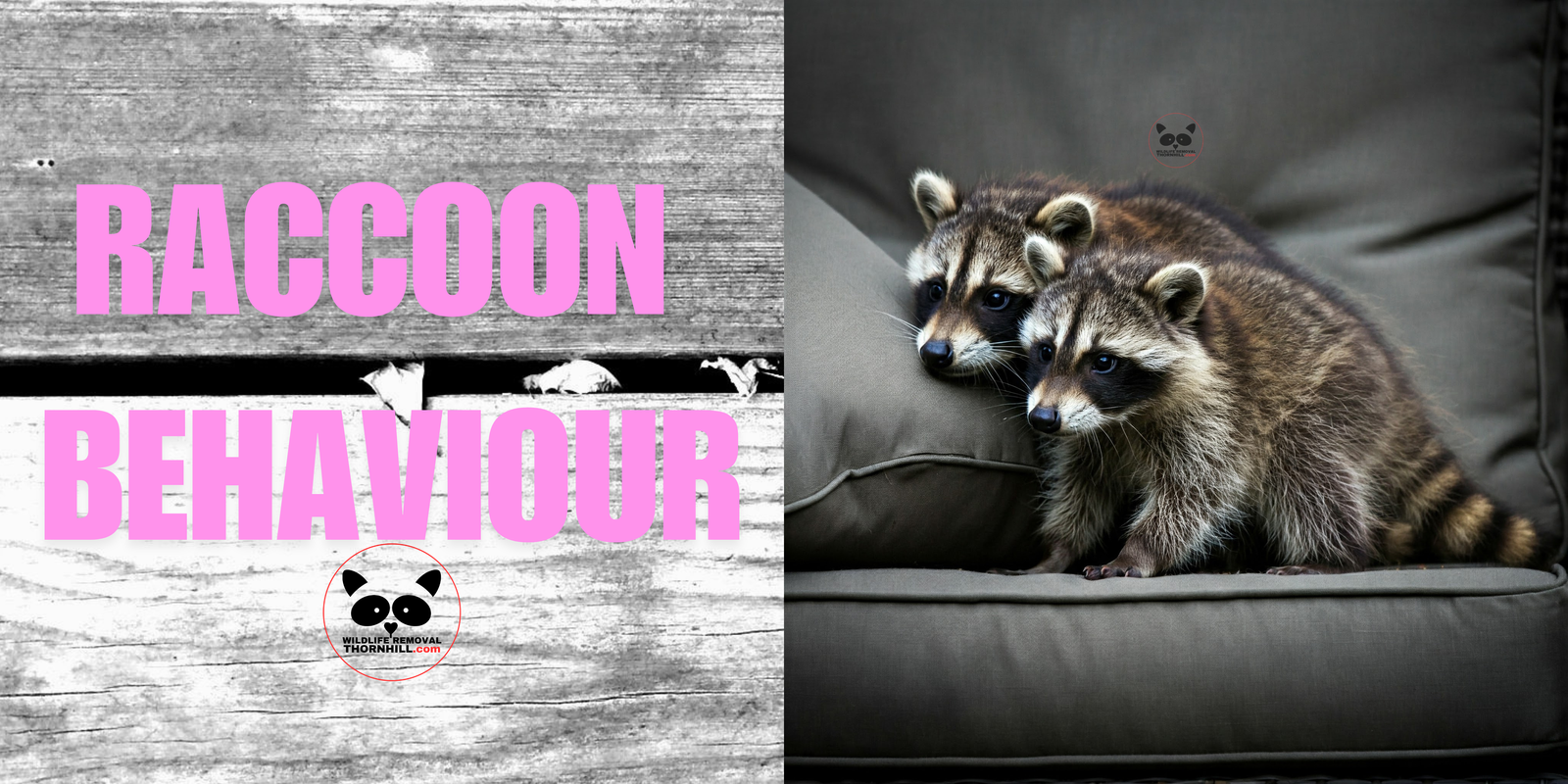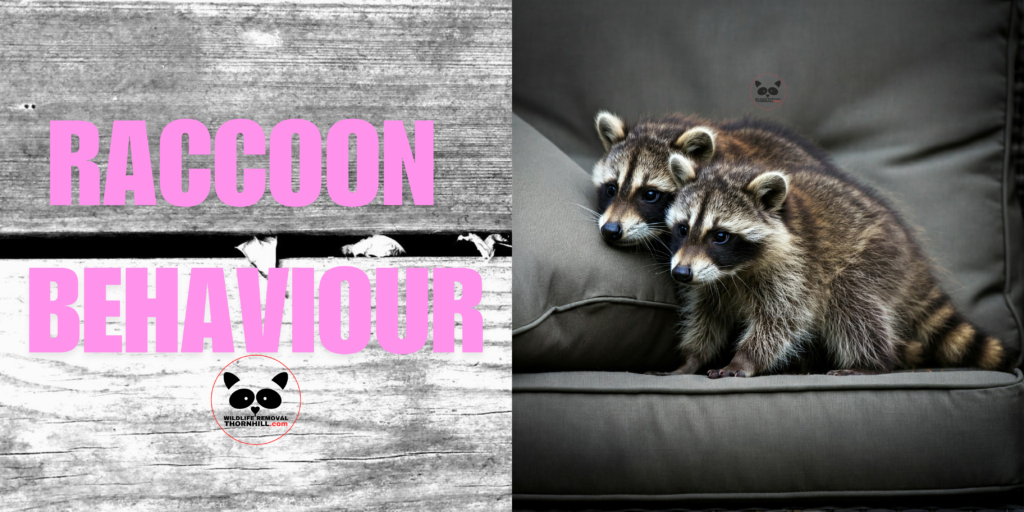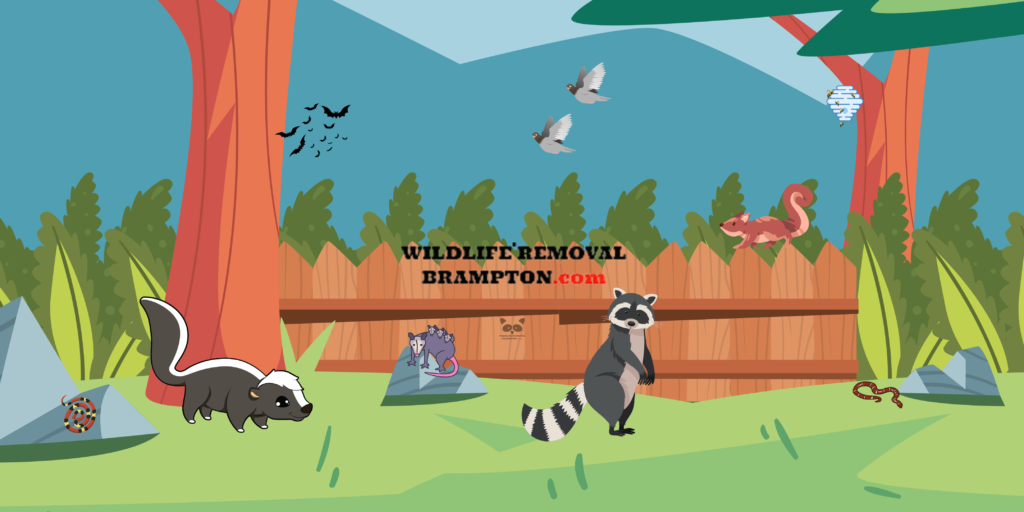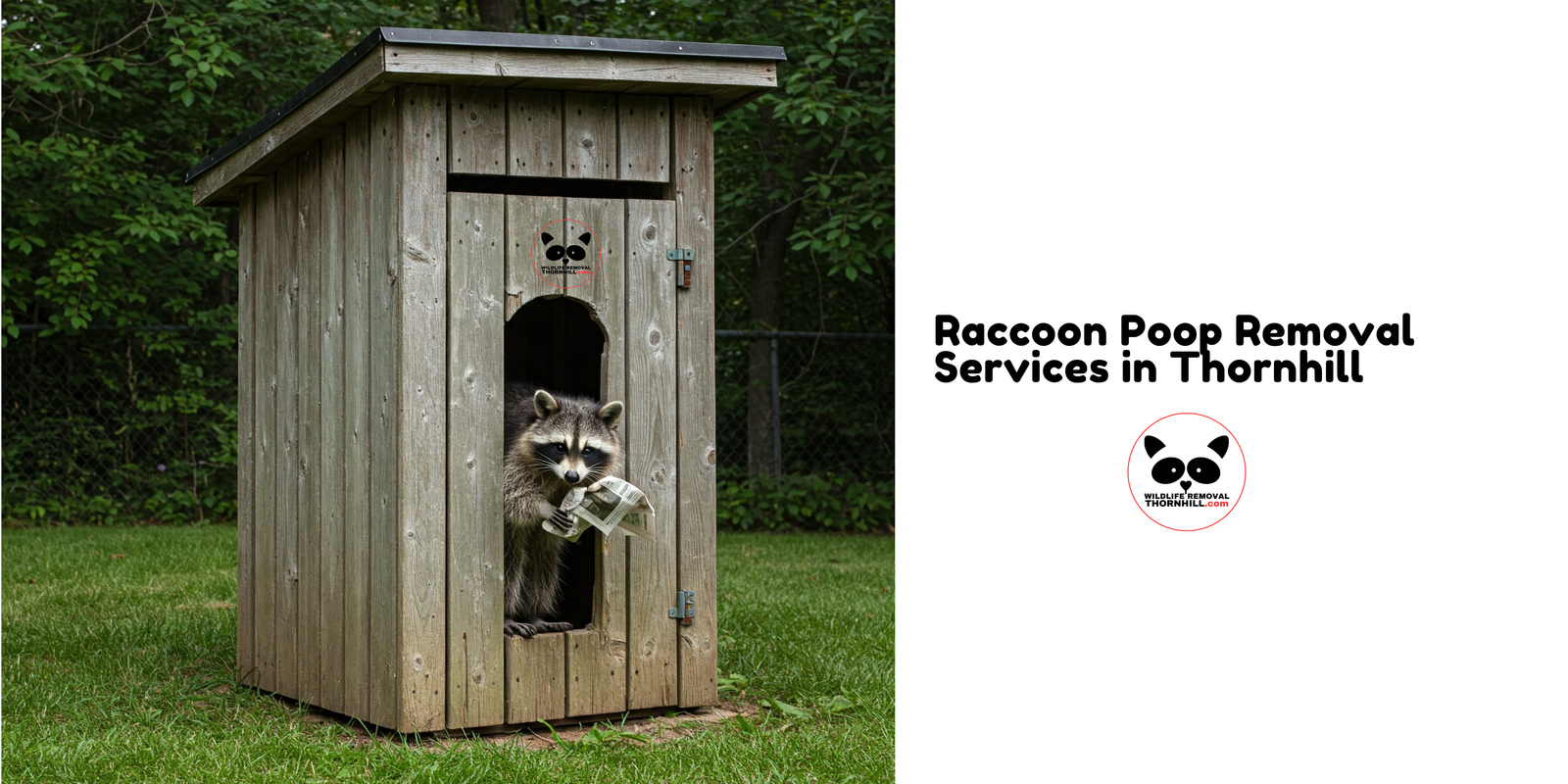Removal of Raccoons From your Home Thornhill Property
- Nocturnal: Raccoons are nocturnal animals, mostly active at night, foraging for food and shelter.
- Diet: They are omnivores, eating fruits, vegetables, insects, small animals and human trash. Some food sources can attract raccoons to urban areas.
- Adaptability: True that they are wild animals but raccoons are very clever creatures and can thrive in almost any urban environments, they make their dens in attics, chimneys or under decks. Raccoons also use crawl spaces for shelter.
How to Identify Raccoons
Physical Characteristics of a Raccoon
Raccoons are medium size mammals, easily identified by their distinctive features. They have a black “mask” around their eyes, gray to black or brown fur and a grizzled look. Their bushy tails are ringed with light and dark bands and they have small round ears. Adult raccoons are 2 to 3 feet long and 10 to 30 pounds. Though they may be cute, don’t fall for their cuteness and feed raccoons (or any other wildlife for that matter) as these wild animals will start to hang around more often, just expecting their next meal.

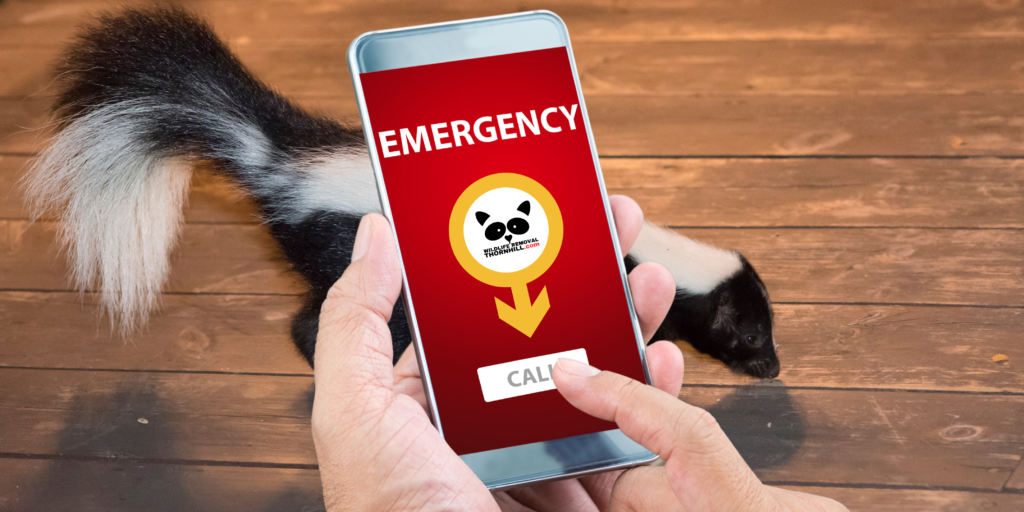
Raccoon Behaviour
Being nocturnal, raccoons are most active at night when they forage for food and explore. Intelligent and curious, they are excellent climbers and will climb trees and raid bird feeders for food. Their curious nature leads them to investigate potential food sources such as vegetable gardens, trash bins, and compost bins, so they are frequent visitors to urban and suburban areas. Raccoons are known to bust in through roof vents, soffits, or even create a hole in the roof itself. During certain times of the year they are even more determined to get inside – during the cold winter months, and when they have baby raccoons to care for. They usually have their babies in the springtime, anywhere from March to May, and raccoon removal from your attic becomes more prevalent than ever during this time. Young raccoons become fully mobile at 8-9 weeks old and stay with their mom until they’re about 8-10 months old.
Raccoon Habitat and Range
Native to North America, raccoons are found throughout the United States and Canada. They are very adaptable and can thrive in any habitat, from dense forests to urban areas. Raccoons are found near water sources like rivers, lakes and backyard ponds where they have food and shelter.
Raccoon Signs and Raccoon Droppings
- Physical Evidence: Droppings, damage to your home, physical sightings
- Tracks: Hand-like prints with 5 fingers.
- Droppings: Tubular shaped poop, 2-3 inches long. Raccoon droppings can be a health risk, roundworm to humans and pets, if your child or pet has come into contact with raccoon feces, seek medical attention immediately
- Damage: Scratches, torn shingles, holes in soffit, open garbage cans, disturbed gardens.
- Audible Cues: Snarls, high pitched sounds, hisses or chattering at night. Strange noises in the attic or chimney are common signs that a raccoon is present inside.
Raccoon Diet
Food Sources
Raccoons are omnivores, they eat both plant and animal matter. They are opportunistic feeders and will eat a wide variety of foods:
- Fruits and berries
- Nuts and seeds
- Insects and grubs
- Small animals, mice and frogs
- Pet food and bird seed
- Trash and garbage
Their adaptability in diet makes them frequent visitors to human habitats where they are attracted to easy food and water sources. Pet food left outdoors and unsecured trash cans are common targets for these clever animals. Raccoons also raid gardens and crops causing damage to plants and property. Their foraging habits can cause raccoon problems, so it’s important to secure access points and food sources to prevent raccoons from becoming a nuisance. There are however, scents and smells that raccoons hate such as hot sauce, vinegar, cayenne pepper that may assist as a raccoon repellent.
Preventative Measures to Raccoons
- Securing Food Sources:
- Garbage Management: Use raccoon-proof garbage bins with locking lids and keep them in secure areas. Unsecured trash attracts raccoons, so keep your garbage containers tightly sealed.
- Pet Food: Feed pets inside and don’t leave food outside overnight as this will keep raccoons and other animals .
- Bird Feeders: Install baffles and clean up spilled seeds to deter raccoons. Remove bird feeders at night to prevent raccoon access.
- Eliminating Shelter Opportunities:
- Seal Entry Points: Inspect and repair any openings in attics, basements, chimneys and under decks. Also inspect crawl spaces for raccoon entry.
- Install Chimney Caps: Use mesh covers to prevent raccoon entry.
- Maintain Landscaping: Trim tree branches away from the house to limit roof access.
Humane Raccoon Removal Techniques
- Encouraging Voluntary Departure:
- Light and Sound: Shine bright lights and play loud music in the affected area to make it unwelcoming.
- Scent Repellent: Spray predator urine around your yard and house, mix cayenne pepper with a bit of water to make a paste, rub globs of it around the base of your deck or shed.
- Odor Repellents: Use ammonia-soaked rags to deter raccoons. Natural deterrents can also encourage raccoons to move to another shelter but they need to be re-applied frequently especially after rain.
- One-Way Exclusion Devices: Contact a reliable wildlife control company to install one-way exit doors on entry points to allow raccoons to exit but not re-enter.
- Live Trapping:
- Considerations: Trapping should only be used as a very last resort to keep raccoons away and is regulated by local laws.
- Professional Assistance: Hire licensed wildlife control professionals to do the trapping and relocation. Professional raccoon removal services will provide effective and humane solutions and will follow local laws to protect all the raccoons.
Post-Removal Actions
- Sanitation: Clean and disinfect areas where raccoons were present to remove odors and reduce disease risk. It’s important to clean areas where raccoon feces have been found to prevent transmission of diseases like Baylisascaris (roundworm). Keep an eye on your small children and pets outside in case
- Repairs: Fix any damage caused by raccoons to prevent future entry, and have prevention meshing attached to any potential entry points.

(647) 490-5317 – Thornhill, ON
When to Call a Professional Raccoon Removal Service
- Persistent Infestation: If you keep up with regular maintenance on your home, you may notice entries or holes in your roof or soffit. At this point trapping will not help keep raccoons away, there will always be another raccoon to take its place. You can end up spending a lot of money on costly repairs to your home without first getting them out and keeping them out. When raccoons keep coming back despite preventative measures call in the professionals.
- Health Risks: When there’s a risk of transmission of canine distemper or or if the raccoon is sick or aggressive.
- Complex Situations: Such as raccoons in hard to reach areas or presence of babies. A mother raccoon and her babies in the chimney requires humane methods for raccoon family management to avoid separating them and causing harm.
